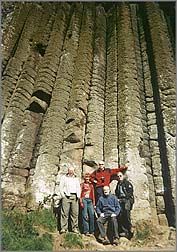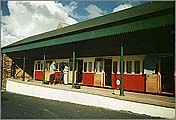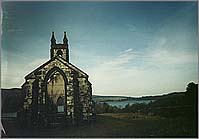Helen Rose's Hillwalking Diary - Northern Ireland
Helen Rose Hill Walking Diary July 2002
North of Ireland

The first article I wrote for this website two years ago was about a trip to the South of Ireland to climb the Irish Munros (mountains over 3,000 feet high). Recently we returned to Ireland, this time to the North to climb some more hills and check out the Irish pub hospitality. It was more or less the same group as the first visit and we had expectations. We were not disappointed - even the weather was wet and windy - just like on our first visit. However, we are a group of tough hillwalkers and quite used to the vagaries of the Scottish weather so it does not hold us back.
As usual, Stephen had done a wonderful job of researching and planning the trip right down to giving descriptions of the walks in a special pack. There were six of us in the group and we had a two car convoy as navigation was difficult at times on the small country roads but the drivers did an excellent job and we always found our destination. We spent the first afternoon at the Giants Causeway in County Antrim which must be one of the wonders of nature with the basalt columns which are also found in the Island of Staffa in Scotland and are in fact a continuation of the same line under the sea. It was brilliant sunny weather so the sun does shine sometimes in Scotland and Ireland but they would not be as green if it were not for the rainfall so we are not complaining.
We moved on to Dungiven in County L'Derry and stayed at a quaint and rustic hostel which is well worth a mention. It is the Flax Mill Hostel ( Tel. (028) 7774 2655) and is a listed building with no electricity, only gas lighting. The owner greeted us with a cup of tea and gave us a choice of rooms which were very individual in character and filled with interesting artefacts. In the evening a peat fire, which heated the building, was lit in the main room and meals were served in the conservatory at the back overlooking the kitchen garden. We spent a day in the nearby Sperrin Mountains and only met one other person on the walk. I had read about exploding peat bogs where water builds up underneath but we did not see any although there were giant peat hags to walk around.

We moved onto Donegal where unfortunately the weather turned a little wild.We spent a very windy day on the Aranmore Island where we walked the Aranmore Way around the Island. Once the village is left behind, it is very remote and deserted on the other side of the island. On our way back to another interesting hostel at Dunfanaghy called Corcreggan Mill - actually converted railway carriages, we passed Errigal, the highest mountain in Donegal and had magnificent clear views. The hostel was very comfortable with a peat fire in the sitting room and a guitar for the use of visitors so we had a good evening in singing along as Jim could play the guitar.
The following day we climbed Errigal and although only 2,466 feet (751 metres) high it is very impressive. Errigal is described as a graceful quartzite cone with long scree slopes falling from a tiny double summit. It is adjacent to Muckish and both sit conspicuously above the surrounding hills and low boglands. We parked just east of Dunlewy and booted up ready to start the walk but the rain started and we waited in the cars for the shower to pass, which fortunately it did within a short time. As the walk was fairly shor,t having a reasonable path and gaining height quickly, we managed to complete it before the next shower in the afternoon. We followed the path across bogland towards Errigal and began the steady climb. As we climbed higher the ground dried out and at the col it became rockier. We sheltered here for elevenses but unfortunately we could not see the summit which was enveloped in mist. However, there were good views of the surrounding country side and over to the poisoned glen and the Derryveagh Mountains. The path to the top was steeper over the scree slopes but it was distinct and zig zagged giving a gentler incline. On the summit, the ridge was narrow with steep ground falling away from it. Surprisingly, there was no wind on the top and we had no luck when we tried to fly the Scottish St. Andrew's flag for a group photo and eventually had to hold it out at the corners. Due to the impending showers we did not extend the walk but retraced our steps back to the cars.

As it was glorious weather the next day, we did our longest walk over the Derryveagh Mountains and had good views over to Errigal. It was a fine long ridge walk over granite mountains with a little scrambling here and there and we were out walkng for nine hours. When the weather is this good, you make the most of it and extend the day. We must have climbed about 5,000 feet as there were a lot of ups and downs but although tired at the end of the walk, it was extremely satisfying and I felt uplifted by the quiet surroundings and the beautiful views. This ridge was different as there were were few peat bogs but evidence of glaciation leading to the highest top of Slieve Snaght. The Poisoned Glen leading back to a ruined church is so called as Petty Spurge and Wood Spurge grow here and are known to make horses and cattle very ill. The ruined church is built from a blend of white marble and granite and refects the contrasting rocks of Snaght (granite) and Errigal (quartzite).
I cannot finish without mentioning the evenings spent singing in the Irish pubs and in particular the Cellar Bar in Donegal Town which was a great night out where the musicians knew every song requested! We sang ourselves silly but we really must learn the words of songs beyond the first verse for our next trip to Ireland. Connemara and Galway next year?
Coming Attractions; Sponsored walk at the Gaick Pass, Weekends at Glen Nevis and the English Lake District.
E mail me at helenrose52@hotmail.com with your comments.
Thanks to Frances Rickus for the photos.







